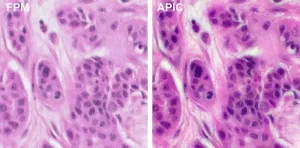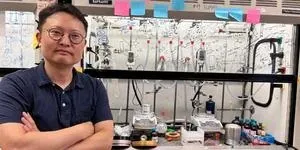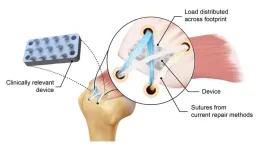(Press-News.org) For hundreds of years, the clarity and magnification of microscopes were ultimately limited by the physical properties of their optical lenses. Microscope makers pushed those boundaries by making increasingly complicated and expensive stacks of lens elements. Still, scientists had to decide between high resolution and a small field of view on the one hand or low resolution and a large field of view on the other.
In 2013, a team of Caltech engineers introduced a microscopy technique called FPM (for Fourier ptychographic microscopy). This technology marked the advent of computational microscopy, the use of techniques that wed the sensing of conventional microscopes with computer algorithms that process detected information in new ways to create deeper, sharper images covering larger areas. FPM has since been widely adopted for its ability to acquire high-resolution images of samples while maintaining a large field of view using relatively inexpensive equipment.
Now the same lab has developed a new method that can outperform FPM in its ability to obtain images free of blurriness or distortion, even while taking fewer measurements. The new technique, described in a paper that appeared in the journal Nature Communications, could lead to advances in such areas as biomedical imaging, digital pathology, and drug screening.
The new method, dubbed APIC (for Angular Ptychographic Imaging with Closed-form method), has all the advantages of FPM without what could be described as its biggest weakness—namely, that to arrive at a final image, the FPM algorithm relies on starting at one or several best guesses and then adjusting a bit at a time to arrive at its "optimal" solution, which may not always be true to the original image.
Under the leadership of Changhuei Yang, the Thomas G. Myers Professor of Electrical Engineering, Bioengineering, and Medical Engineering and an investigator with the Heritage Medical Research Institute, the Caltech team realized that it was possible to eliminate this iterative nature of the algorithm.
Rather than relying on trial and error to try to home in on a solution, APIC solves a linear equation, yielding details of the aberrations, or distortions introduced by a microscope's optical system. Once the aberrations are known, the system can correct for them, basically performing as though it is ideal, and yielding clear images covering large fields of view.
"We arrive at a solution of the high-resolution complex field in a closed-form fashion, as we now have a deeper understanding in what a microscope captures, what we already know, and what we need to truly figure out, so we don't need any iteration,” says Ruizhi Cao (PhD '24), co-lead author on the paper, a former graduate student in Yang's lab, and now a postdoctoral scholar at UC Berkeley. "In this way, we can basically guarantee that we are seeing the true final details of a sample."
As with FPM, the new method measures not only the intensity of the light seen through the microscope but also an important property of light called “phase,” which is related to the distance that light travels. This property goes undetected by human eyes but contains information that is very useful in terms of correcting aberrations. It was in solving for this phase information that FPM relied on a trial-and-error method, explains Cheng Shen (PhD '23), co-lead author on the APIC paper, who also completed the work while in Yang's lab and is now a computer vision algorithm engineer at Apple. "We have proven that our method gives you an analytical solution and in a much more straightforward way. It is faster, more accurate, and leverages some deep insights about the optical system."
Beyond eliminating the iterative nature of the phase-solving algorithm, the new technique also allows researchers to gather clear images over a large field of view without repeatedly refocusing the microscope. With FPM, if the height of the sample varied even a few tens of microns from one section to another, the person using the microscope would have to refocus in order to make the algorithm work. Since these computational microscopy techniques frequently involve stitching together more than 100 lower-resolution images to piece together the larger field of view, that means APIC can make the process much faster and prevent the possible introduction of human error at many steps.
"We have developed a framework to correct for the aberrations and also to improve resolution,” says Cao. "Those two capabilities can be potentially fruitful for a broader range of imaging systems."
Yang says the development of APIC is vital to the broader scope of work his lab is currently working on to optimize image data input for artificial intelligence (AI) applications. "Recently, my lab showed that AI can outperform expert pathologists at predicting metastatic progression from simple histopathology slides from lung cancer patients," says Yang. "That prediction ability is exquisitely dependent on obtaining uniformly in-focus and high-quality microscopy images, something that APIC is highly suited for."
The paper, titled, "High-resolution, large field-of-view label-free imaging via aberration-corrected, closed-form complex field reconstruction" appeared online in Nature Communications on June 3. The work was supported by the Heritage Medical Research Institute.
For hundreds of years, the clarity and magnification of microscopes were ultimately limited by the physical properties of their optical lenses. Microscope makers pushed those boundaries by making increasingly complicated and expensive stacks of lens elements. Still, scientists had to decide between high resolution and a small field of view on the one hand or low resolution and a large field of view on the other.
In 2013, a team of Caltech engineers introduced a microscopy technique called FPM (for Fourier ptychographic microscopy). This technology marked the advent of computational microscopy, the use of techniques that wed the sensing of conventional microscopes with computer algorithms that process detected information in new ways to create deeper, sharper images covering larger areas. FPM has since been widely adopted for its ability to acquire high-resolution images of samples while maintaining a large field of view using relatively inexpensive equipment.
Now the same lab has developed a new method that can outperform FPM in its ability to obtain images free of blurriness or distortion, even while taking fewer measurements. The new technique, described in a paper that appeared in the journal Nature Communications, could lead to advances in such areas as biomedical imaging, digital pathology, and drug screening.
The new method, dubbed APIC (for Angular Ptychographic Imaging with Closed-form method), has all the advantages of FPM without what could be described as its biggest weakness—namely, that to arrive at a final image, the FPM algorithm relies on starting at one or several best guesses and then adjusting a bit at a time to arrive at its "optimal" solution, which may not always be true to the original image.
Under the leadership of Changhuei Yang, the Thomas G. Myers Professor of Electrical Engineering, Bioengineering, and Medical Engineering and an investigator with the Heritage Medical Research Institute, the Caltech team realized that it was possible to eliminate this iterative nature of the algorithm.
Rather than relying on trial and error to try to home in on a solution, APIC solves a linear equation, yielding details of the aberrations, or distortions introduced by a microscope's optical system. Once the aberrations are known, the system can correct for them, basically performing as though it is ideal, and yielding clear images covering large fields of view.
"We arrive at a solution of the high-resolution complex field in a closed-form fashion, as we now have a deeper understanding in what a microscope captures, what we already know, and what we need to truly figure out, so we don't need any iteration,” says Ruizhi Cao (PhD '24), co-lead author on the paper, a former graduate student in Yang's lab, and now a postdoctoral scholar at UC Berkeley. "In this way, we can basically guarantee that we are seeing the true final details of a sample."
As with FPM, the new method measures not only the intensity of the light seen through the microscope but also an important property of light called “phase,” which is related to the distance that light travels. This property goes undetected by human eyes but contains information that is very useful in terms of correcting aberrations. It was in solving for this phase information that FPM relied on a trial-and-error method, explains Cheng Shen (PhD '23), co-lead author on the APIC paper, who also completed the work while in Yang's lab and is now a computer vision algorithm engineer at Apple. "We have proven that our method gives you an analytical solution and in a much more straightforward way. It is faster, more accurate, and leverages some deep insights about the optical system."
Beyond eliminating the iterative nature of the phase-solving algorithm, the new technique also allows researchers to gather clear images over a large field of view without repeatedly refocusing the microscope. With FPM, if the height of the sample varied even a few tens of microns from one section to another, the person using the microscope would have to refocus in order to make the algorithm work. Since these computational microscopy techniques frequently involve stitching together more than 100 lower-resolution images to piece together the larger field of view, that means APIC can make the process much faster and prevent the possible introduction of human error at many steps.
"We have developed a framework to correct for the aberrations and also to improve resolution,” says Cao. "Those two capabilities can be potentially fruitful for a broader range of imaging systems."
Yang says the development of APIC is vital to the broader scope of work his lab is currently working on to optimize image data input for artificial intelligence (AI) applications. "Recently, my lab showed that AI can outperform expert pathologists at predicting metastatic progression from simple histopathology slides from lung cancer patients," says Yang. "That prediction ability is exquisitely dependent on obtaining uniformly in-focus and high-quality microscopy images, something that APIC is highly suited for."
The paper, titled, "High-resolution, large field-of-view label-free imaging via aberration-corrected, closed-form complex field reconstruction" appeared online in Nature Communications on June 3. The work was supported by the Heritage Medical Research Institute.
END
New computational microscopy technique provides more direct route to crisp images
Caltech's new analytical method eliminates guesswork, leading to true high-resolution images covering a large field of view
2024-06-28
ELSE PRESS RELEASES FROM THIS DATE:
11th-grade student wins competition with research conducted at UTA
2024-06-28
A Plano high school student conducting research in a University of Texas at Arlington chemistry professor’s lab earned multiple awards at the annual Regeneron International Science and Engineering Fair (ISEF). Regeneron ISEF is the world’s largest pre-college STEM competition for students in grades 9-12.
Chloe Lee, a junior in the International Baccalaureate program at Plano East Senior High School, conducted research in the lab of Junha Jeon, associate professor of chemistry and ...
Deep learning-assisted lesion segmentation in PET/CT imaging: A feasibility study for salvage radiation therapy in prostate cancer
2024-06-28
“The deployment of DL segmentation methods in 18F-fluciclovine PET/CT imaging represents an intriguing research direction for precision medicine in salvage prostate cancer care.”
BUFFALO, NY- June 28, 2024 – A new editorial paper was published in Oncoscience (Volume 11) on May 20, 2024, entitled, “Deep learning-assisted lesion segmentation in PET/CT imaging: A feasibility study for salvage radiation therapy in prostate cancer.”
In this new editorial, researchers Richard L.J. Qiu, Chih-Wei Chang, ...
Dementia cost calculator will provide precise, annual, national estimates of Alzheimer's financial toll
2024-06-28
An A-list of researchers from across USC is building a dementia cost model that will generate comprehensive national, annual estimates of the cost of dementia that could benefit patients and their families, thanks to a five-year, $8.2 million federal grant from the National Institute on Aging.
A firm grip on the costs of the disease could assist families living with dementia with planning their budgets and support needs, inform treatment and caregiving options, and help shape health care policy.
“We currently have estimates for a particular ...
Moffitt researchers develop synthesis method to enhance access to cancer-fighting withanolides
2024-06-28
TAMPA, Fla. — Withanolides, a class of naturally occurring compounds found in plants, have long been a focus of cancer research due to their ability to inhibit cancer cell growth, induce cell death and prevent metastasis. These compounds are important in developing new cancer treatments. However, the difficulty of obtaining enough of these compounds from plants has hindered research and therapeutic development.
Moffitt Cancer Center researchers have developed a groundbreaking method for the scalable synthesis of withanolides. This innovative approach, published in Science Advances, could revolutionize cancer research by providing ...
Analysis of NASA InSight data suggests Mars hit by meteoroids more often than thought
2024-06-28
PROVIDENCE, R.I. [Brown University] — NASA’s Mars InSight Lander may be resting on the Red Planet in retirement, but data from the robotic explorer is still leading to seismic discoveries on Earth.
In one of the latest studies using data from the spacecraft, an international team of scientists led by a Brown University researcher found that Mars may be getting bombarded by space rocks at more frequent rates than previously thought. Impact rates could be two to 10 times higher than previously estimated, depending on the size of the meteoroids, according to the study published in Science Advances.
“It’s ...
Serotonin 2C receptor regulates memory in mice and humans – implications for Alzheimer’s disease
2024-06-28
Researchers at Baylor College of Medicine, the University of Cambridge in the U.K. and collaborating institutions have shown that serotonin 2C receptor in the brain regulates memory in people and animal models. The findings, published in the journal Science Advances, not only provide new insights into the factors involved in healthy memory but also in conditions associated with memory loss, like Alzheimer’s disease, and suggest novel avenues for treatment.
“Serotonin, a compound produced by neurons in the midbrain, acts as a neurotransmitter, passing messages between brain cells,” said co-corresponding author Dr. Yong Xu, professor of pediatrics ...
New device inspired by python teeth doubles strength of rotator cuff repairs
2024-06-28
New York, NY—June 24, 2024—Most people, when they think about pythons, visualize the huge snake constricting and swallowing victims whole. But did you know that pythons initially hold onto their prey with their sharp, backward-curving teeth? Medical researchers have long been aware that these teeth are perfect for grasping soft tissue rather than cutting through it, but no one has yet been able to put this concept into surgical practice. Over the years, mimicking these teeth for use in surgery has been a frequent topic ...
The beginnings of fashion
2024-06-28
EMBARGO: 4:00 Sydney AEST June 29 | 14:00 US ET June 28 2024
The beginnings of fashion
Paleolithic eyed needles and the evolution of dress
A team of researchers led by an archaeologist at the University of Sydney are the first to suggest that eyed needles were a new technological innovation used to adorn clothing for social and cultural purposes, marking the major shift from clothes as protection to clothes as an expression of identity.
“Eyed needle tools are an important development in prehistory because they document a transition in the function of clothing from utilitarian to social purposes,” says Dr Ian Gilligan, Honorary Associate ...
Why some tumors are resistant to cell therapies
2024-06-28
FRANKFURT. In congratulating the CARISMa scientists, Goethe University President Prof. Enrico Schleiff said: “The new LOEWE network sets up in Hesse an innovative research program that is currently gathering steam all over the world. It also expands Goethe University’s existing research profile and broadens our network of cooperation partners in the field of CAR cell therapy [editor’s note: CAR is the abbreviation for chimeric antigen receptor]. The network deliberately builds on our university’s ...
Can A.I. tell you if you have osteoporosis? Newly developed deep learning model shows promise
2024-06-28
Osteoporosis is so difficult to detect in early stage it’s called the “silent disease.” What if artificial intelligence could help predict a patient’s chances of having the bone-loss disease before ever stepping into a doctor’s office?
Tulane University researchers made progress toward that vision by developing a new deep learning algorithm that outperformed existing computer-based osteoporosis risk prediction methods, potentially leading to earlier diagnoses and better outcomes for patients with osteoporosis risk.
Their results were recently published in ...
LAST 30 PRESS RELEASES:
The (metabolic) cost of life
CFRI special issue call for papers: New Frontiers in Sustainable Finance
HKU Engineering scholar demonstrates the smallest all-printed infrared photodetectors to date
Precision empowerment for brain "eavesdropping": CAS team develops triple-electrode integrated functional electrode for simultaneous monitoring of neural signals and chemical transmitters during sleep
Single-capillary endothelial dysfunction resolved by optoacoustic mesoscopy
HKU three research projects named among ‘Top 10 Innovation & Technology News in Hong Kong 2025’ showcasing excellence in research and technology transfer
NLRSeek: A reannotation-based pipeline for mining missing NLR genes in sequenced genomes
A strand and whole genome duplication–aware collinear gene identification tool
Light storage in light cages: A revolutionary approach to on-chip quantum memories
Point spread function decoupling in computational fluorescence microscopy
BacPhase: Long-insert paired-end sequencing for bin marker construction and genome phasing
GmWOX1 regulates the mediolateral polarity of compound leaves in soybean
ChargeFabrica: An open-source simulation tool that aims to accelerate search for high performance perovskite solar cells
High levels of ADAR overexpression induce abundant and stochastic off-target RNA editing in rice protoplasts
On-demand upgraded recycling of polyethylene and construction of sustainable multifunctional materials based on the "LEGO" strategy
New "Stomata in-sight" system allows scientists to watch plants breathe in real-time
Anorexia nervosa may result in long-term skeletal muscle impairment
Narrative-based performance reviews deemed fairest by employees
New insights reveal how advanced oxidation can tackle emerging water pollutants
New review shows how biomass can deliver low-carbon gaseous fuels at scale
Climate change is quietly rewriting the world’s nitrogen cycle, with high stakes for food and the environment
Study finds SGLT-2 inhibitors linked to lower risk of diabetic foot nerve damage
Microbes may hold the key to brain evolution
Study examines how the last two respiratory pandemics rapidly spread through cities
Gender stereotypes reflect the division of labor between women and men across nations
Orthopedics can play critical role in identifying intimate partner violence
Worms as particle sweepers
Second spider-parasitic mite described in Brazil
January 2026 issues of APA journals feature new research on autism, pediatric anxiety, psychedelic therapy, suicide prevention and more
Private equity acquired more than 500 autism centers over the past decade, new study shows
[Press-News.org] New computational microscopy technique provides more direct route to crisp imagesCaltech's new analytical method eliminates guesswork, leading to true high-resolution images covering a large field of view






